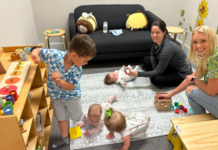In the first weeks of parenting, new parents get advice from all directions. Whether they want it or not.
When my son was born, we lived in North Carolina. Our county sent a health visitor to meet with each new parent, to make sure everything was going well and to pass on parenting tips.
Our health visitor was a brisk, efficient woman in her 50s. She was kind and thorough, but when she handed me a pamphlet on the importance of reading to my new baby, I felt like a kid being given a homework assignment for summer vacation.
“You should read to your baby at bedtime,” she said. “And when you read to your child, try to read something with rhymes. That’s been shown to stimulate brain development.”
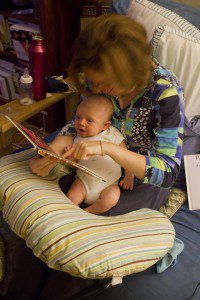
She was just doing her job. We had plenty of books to read to our new baby, and I fully intended to give him the chance to be a bookworm, as I had been. But at that point, I was barely getting a shower each day, let alone having a solid bedtime routine that I could slip a session of nursery rhymes into.
So I politely took the sheaf of papers and said thank you, but in my head all I could say was, “Yeah, right.”
I was reminded of this when the American Academy of Pediatrics announced a new push to get parents to read to children from birth. At a stage of parenting when everything is strange and new, and it can take two hours to get everyone dressed and out of the house, reading to an infant can feel like misspent energy. But now that I’m on the other side of those sleep-deprived first months, I know that reading to a baby doesn’t have to be an arduous task.
At a minimum, reading to a baby lets them hear your voice, which helps develop listening skills. If your baby’s in a snuggling mood, she can hear your heartbeat. She heard your voice and your heartbeat in the womb, and they can be comforting now. If she can see your mouth, that’s an early step in speech development; she learns how you move your mouth when you make certain sounds, and when she’s ready she mimics your movements.
You don’t need to be reading a children’s book, or any book at all, for these benefits. You can read the newspaper or Entertainment Weekly or the back of a cereal box. My mom cherishes the memory of my dad reading to me the summer I was born; he sat cross-legged on the floor, with me in his lap and the newspaper spread out around him. He read aloud about the New York city blackout, or the death of Elvis Presley, or the ups and downs of the Carter administration, and I was content to nestle in his arms and listen to his voice.
As your baby gets older, it may seem that he doesn’t want to be read to, as his tiny arms reach out and smack the book out of your hands. Remember that your baby is developing motor skills. When he knocks the book out of your hand, he may be just testing what his arms can do.
And it may be that he isn’t in the mood to read right then, but that doesn’t mean you should give up entirely. Try another day, or a different time of day. Reading at bedtime is a great routine if it works for you and your child. But if your baby is typically fussy then, or if that’s a busy time of day, then change things up. Reading has benefits no matter when you do it.

As with many things in parenting, try not to let perfect be the enemy of good. Each time you read to your baby, you’re helping her. If that happens once a week, fine; that’s better than not at all.
Okay, so now you know you can handle this reading-to-a-baby thing. But what do you read? The library and the bookstore are so filled with books that it’s hard to know what to choose. Breathe regular: For the first few months at least, it doesn’t matter what you read. So you have some time to try books out and decide what you like to read. (Take it from me, someone who is deep in the preschool years: You don’t want your child to fall in love with a book you hate, because you will read it every.single.day.)
Need suggestions? Here are some of our family’s favorite books for infants and young toddlers.
Daddy Kisses and Mommy Hugs
By Anne Gutman and Georg Hallensleben I simply adore these books. Adore. They are sweet and simple, with lovely soft illustrations. Each book shows how mommy and daddy animals hug and kiss their babies. With a very young infant, you might just read them straight through; but with older infants and toddlers, there is room to play. Daddy Kisses shows each animal kissing his baby in a different spot: “Daddy wolf gives his pup a kiss on the nose.” As I read to Will, I planted a kiss on his nose or neck or hand, and he shrieked with laughter. In Mommy Hugs, each animal hugs her baby in a different manner: “Mommy parrot hugs her chick with a nibble.” I’d pretend to bite his ear and he’d giggle. An excuse to love on my baby and it’s good for him? Sign me up.
I simply adore these books. Adore. They are sweet and simple, with lovely soft illustrations. Each book shows how mommy and daddy animals hug and kiss their babies. With a very young infant, you might just read them straight through; but with older infants and toddlers, there is room to play. Daddy Kisses shows each animal kissing his baby in a different spot: “Daddy wolf gives his pup a kiss on the nose.” As I read to Will, I planted a kiss on his nose or neck or hand, and he shrieked with laughter. In Mommy Hugs, each animal hugs her baby in a different manner: “Mommy parrot hugs her chick with a nibble.” I’d pretend to bite his ear and he’d giggle. An excuse to love on my baby and it’s good for him? Sign me up.
The authors have two more books, which I haven’t read: Mommy Loves and Daddy Cuddles.
The Fire Engine Book
By Tibor Gergely Like many of our favorite books, this was a gift — thank heavens for experienced parents who pass on their best finds! Will has been gaga for fire trucks since early days, so for a long time this was in heavy rotation. The detailed illustrations offer a lot to look at, and a lot for you to point out. Count the firefighters or the ladders; point out the colors of the fire engine and the firefighters’ uniforms; name the objects the firefighters save from the burning building. Even if your child can’t understand these terms yet, you’re laying the groundwork for future language development.
Like many of our favorite books, this was a gift — thank heavens for experienced parents who pass on their best finds! Will has been gaga for fire trucks since early days, so for a long time this was in heavy rotation. The detailed illustrations offer a lot to look at, and a lot for you to point out. Count the firefighters or the ladders; point out the colors of the fire engine and the firefighters’ uniforms; name the objects the firefighters save from the burning building. Even if your child can’t understand these terms yet, you’re laying the groundwork for future language development.
Freight Train
By Donald Crews I didn’t get the appeal of this book at first. But the simple illustrations and spare text grew on me. There isn’t really a plot; it’s more of a description. Each car is a different color and has a different function. The train moves across the tracks and then … it’s gone. This proves you don’t need a complicated plot to hold children’s attention. Freight Train won a Caldecott Honor in 1979, and School Library Journal recently named it to its list of the best 100 picture books.
I didn’t get the appeal of this book at first. But the simple illustrations and spare text grew on me. There isn’t really a plot; it’s more of a description. Each car is a different color and has a different function. The train moves across the tracks and then … it’s gone. This proves you don’t need a complicated plot to hold children’s attention. Freight Train won a Caldecott Honor in 1979, and School Library Journal recently named it to its list of the best 100 picture books.
Global Babies
By the Global Fund for Children I love watching babies discover other babies. They’re fascinated with this other little person; it’s as if they thought they were the only small one around. So this book, with images of babies from cultures around the world, is on my list of favorites. There are sleeping babies and awake babies; babies in simple clothes and babies in fancy attire; babies strapped to their mothers’ backs and babies who look ready to roam. But the theme that runs through the book is that no matter where babies live, they are all special and loved.
I love watching babies discover other babies. They’re fascinated with this other little person; it’s as if they thought they were the only small one around. So this book, with images of babies from cultures around the world, is on my list of favorites. There are sleeping babies and awake babies; babies in simple clothes and babies in fancy attire; babies strapped to their mothers’ backs and babies who look ready to roam. But the theme that runs through the book is that no matter where babies live, they are all special and loved.
The Going to Bed Book
By Sandra Boynton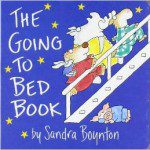 Sandra Boynton is a familiar name to many parents; her books offer silly, appealing rhymes. But this is my favorite of her books, because of the last line: “The moon is high, the sea is deep; they rock and rock and rock to sleep.” It’s right up there with Robert Frost’s “lovely, dark and deep” woods for me. Will is nearly 4 and I still keep this on his shelf in hopes of including it in our bedtime rotation. But before that quiet closing, the book offers plenty of silliness: animals bathing together, mixing up their pajamas, and then doing group exercise on the deck of a ship.
Sandra Boynton is a familiar name to many parents; her books offer silly, appealing rhymes. But this is my favorite of her books, because of the last line: “The moon is high, the sea is deep; they rock and rock and rock to sleep.” It’s right up there with Robert Frost’s “lovely, dark and deep” woods for me. Will is nearly 4 and I still keep this on his shelf in hopes of including it in our bedtime rotation. But before that quiet closing, the book offers plenty of silliness: animals bathing together, mixing up their pajamas, and then doing group exercise on the deck of a ship.
Good Dog, Carl
By Alexandra Day Reading this book requires a certain imagination and energy. There are very few words, so you make up a story to go along with the gorgeous, oil-painting-like images. The illustrations show a dog, charged with taking care of a baby, who makes a mess and then cleans it up before the parents get home. But as long as you stick to that loose plot, you can add as much detail as you want — great for when a baby just wants to be held and read to.
Reading this book requires a certain imagination and energy. There are very few words, so you make up a story to go along with the gorgeous, oil-painting-like images. The illustrations show a dog, charged with taking care of a baby, who makes a mess and then cleans it up before the parents get home. But as long as you stick to that loose plot, you can add as much detail as you want — great for when a baby just wants to be held and read to.
The Little Train
By Lois Lenski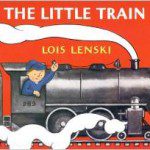 I knew Lois Lenski as the illustrator of the beloved Betsy-Tacy series, and I’d read a few of her children’s novels. But it turns out she wrote a series of books for young children as well. Her character, Mr. Small, drives a car, skippers a boat, flies a plane, and runs a farm. In The Little Train, he is an engineer taking a train from a small town to a big city. The pen-and-ink illustrations describe the parts of a train — ideal for toddlers obsessed with transportation — and follow its journey through the countryside and into the station. Among the passengers are a little boy and a little girl — perfect standins for your little one.
I knew Lois Lenski as the illustrator of the beloved Betsy-Tacy series, and I’d read a few of her children’s novels. But it turns out she wrote a series of books for young children as well. Her character, Mr. Small, drives a car, skippers a boat, flies a plane, and runs a farm. In The Little Train, he is an engineer taking a train from a small town to a big city. The pen-and-ink illustrations describe the parts of a train — ideal for toddlers obsessed with transportation — and follow its journey through the countryside and into the station. Among the passengers are a little boy and a little girl — perfect standins for your little one.
Nosh, Schlep, Schluff: Babyiddish
By Laurel Snyder; illustrated by Tiphanie Beeke This book is just plain fun. Charming rhymes explain Yiddish terms such as bissel, kibbitz and kvell. If your family is Jewish, many of the terms will be familiar to you; if not, you’ll still enjoy the pastel illustrations that show a toddler going about his day, with a froggy friend in tow. And you may find new words to add to your vocabulary — after all, who hasn’t had a kvetchy (grouchy) day, children included?
This book is just plain fun. Charming rhymes explain Yiddish terms such as bissel, kibbitz and kvell. If your family is Jewish, many of the terms will be familiar to you; if not, you’ll still enjoy the pastel illustrations that show a toddler going about his day, with a froggy friend in tow. And you may find new words to add to your vocabulary — after all, who hasn’t had a kvetchy (grouchy) day, children included?
Time for Bed
By Mem Fox; illustrated by Jane Dyer One of the reviews on the back of our copy calls this book “a pleasant prelude to slumber,” and that about says it all. As night falls, animal parents settle their babies in for the night: “It’s time for bed, little sheep, little sheep; the whole wide world is going to sleep.” The last pages show a human child being tucked in (it could be a boy or a girl) and then falling fast asleep. Read this in a soft voice and end in a whisper; your child will drift off and you may want to, too.
One of the reviews on the back of our copy calls this book “a pleasant prelude to slumber,” and that about says it all. As night falls, animal parents settle their babies in for the night: “It’s time for bed, little sheep, little sheep; the whole wide world is going to sleep.” The last pages show a human child being tucked in (it could be a boy or a girl) and then falling fast asleep. Read this in a soft voice and end in a whisper; your child will drift off and you may want to, too.
Wheels on the Bus
By Raffi; illustrated by Sylvie Kantorovitz Wickstrom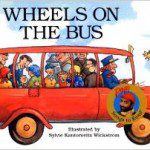 You might be surprised that I’m recommending a Wheels on the Bus book; after all, the song is the original earworm. But you’re not going to be able to escape the song, so you might as well introduce it on your terms. And this book is perfect for my favorite parenting goofiness: silly voices. The illustrations show a French-looking village, so why not sing/read the book with a French accent? Who cares if you sound more like Pepe Le Pew? Your baby doesn’t know! Sing along with me now: “Ze wheels on ze bus go round and round, all t’rough ze town!”
You might be surprised that I’m recommending a Wheels on the Bus book; after all, the song is the original earworm. But you’re not going to be able to escape the song, so you might as well introduce it on your terms. And this book is perfect for my favorite parenting goofiness: silly voices. The illustrations show a French-looking village, so why not sing/read the book with a French accent? Who cares if you sound more like Pepe Le Pew? Your baby doesn’t know! Sing along with me now: “Ze wheels on ze bus go round and round, all t’rough ze town!”
What books did you read to your baby?


